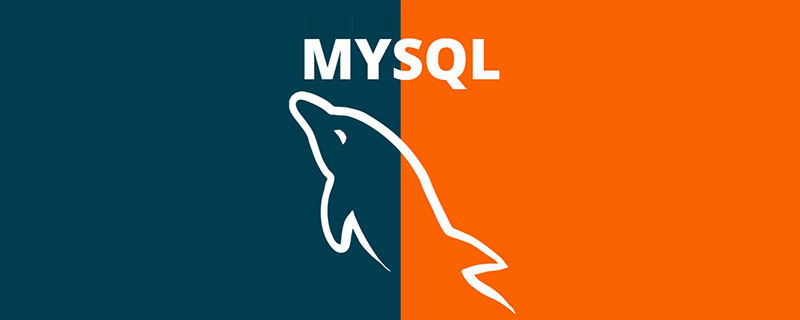Introducing several ways to replicate tables in MySQL
Several ways to copy a table
- Copy onlytable structure
create table tableName like someTable;
Only the table structure, including primary keys and indexes, will be copied, but the table data will not be copied
- Only the table data will be copied
##create table tableName select * from someTable;Copy the general structure of the table and all data, and will not copy the primary key, index, etc.
- Complete copy
create table tableName like someTable;insert into tableName select * from someTable;
Complete in two steps, copy first Table structure, then insert data
Related free learning recommendations:
Example
- Connect to the database, use the student database and view all data tables
-
USE student;SHOW TABLES;
Copy after login
 2. Create the t1 data table and insert two items Record and set the index for the name field
2. Create the t1 data table and insert two items Record and set the index for the name field
CREATE TABLE t1(
id INT NOT NULL AUTO_INCREMENT PRIMARY KEY,
name VARCHAR(50) COMMENT '姓名');INSERT INTO t1(name) VALUES('张三');INSERT INTO t1(name) VALUES('李四');CREATE INDEX idx_name ON t1(name);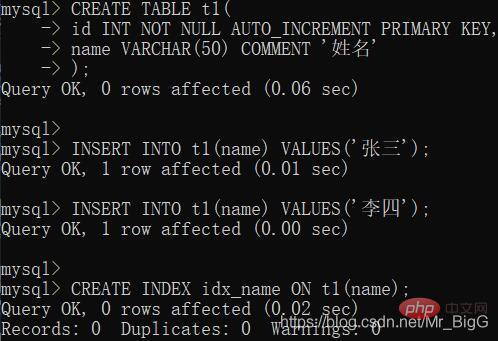 3. View all records of the t1 data table
3. View all records of the t1 data table
SELECT * FROM t1;
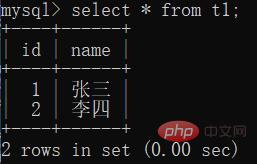 4. View the index of the t1 data table
4. View the index of the t1 data table
SHOW INDEX FROM t1\G;
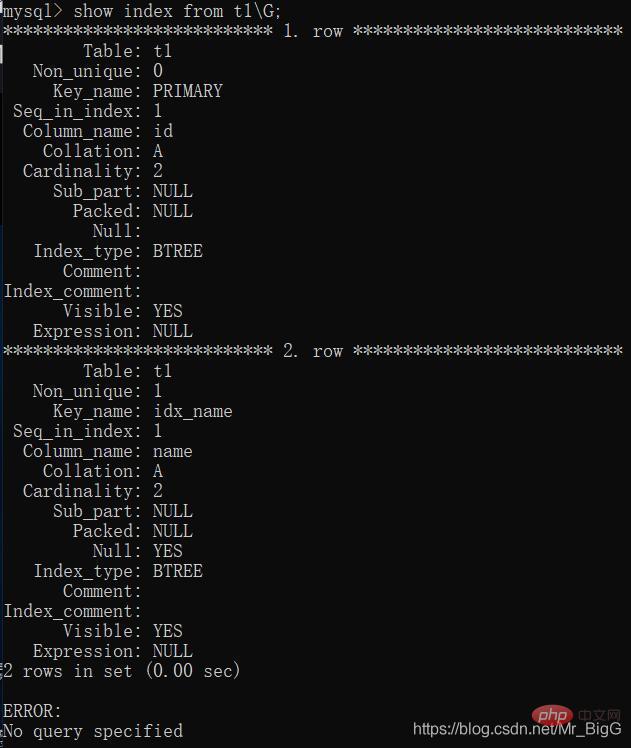 5. Create the t2 data table (only copy the table structure)
5. Create the t2 data table (only copy the table structure)
CREATE TABLE t2 LIKE t1;
 6. View the records of the t2 data table
6. View the records of the t2 data table
SELECT * FROM t2;
 7. View the index of the t2 data table
7. View the index of the t2 data table
SHOW INDEX FROM t2\G;
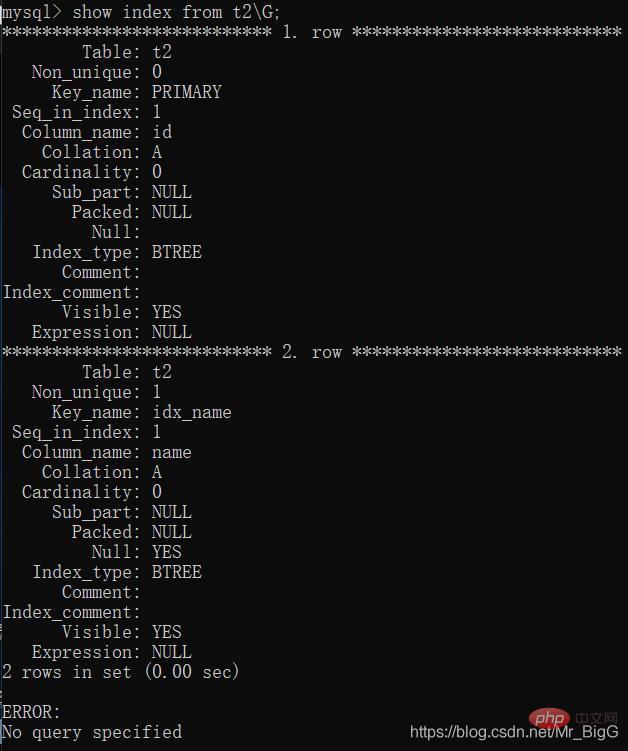 8. View the structure of the t2 data table
8. View the structure of the t2 data table
SHOW CREATE TABLE t2\G;
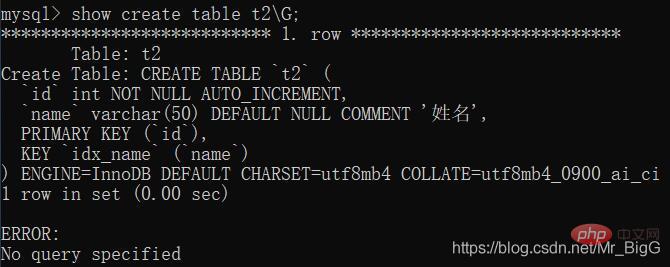 9. Create the t3 data table ( Only copy table data)
9. Create the t3 data table ( Only copy table data)
CREATE TABLE t3 SELECT * FROM t1;
 10. View the table structure of the t3 data table
10. View the table structure of the t3 data table
SHOW CREATE TABLE t3\G;
 11. View the index of the t3 data table
11. View the index of the t3 data table
SHOW INDEX FROM t3;
 12. View all records of the t3 data table
12. View all records of the t3 data table
SELECT * FROM t3;
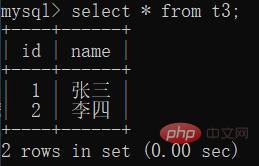 13. Create t4 data table (complete copy)
13. Create t4 data table (complete copy)
CREATE TABLE t4 LIKE t1;INSERT INTO t4 SELECT * FROM t1;
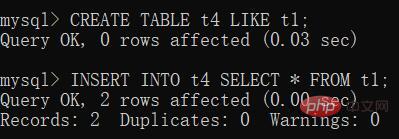 14. View the structure of t4 data table
14. View the structure of t4 data table
SHOW CREATE TABLE t4\G;
 15. View the index of the t4 data table
15. View the index of the t4 data table
SHOW INDEX FROM t4\G;
 16. View all records of the t4 data table
16. View all records of the t4 data table
SELECT * FROM t4;
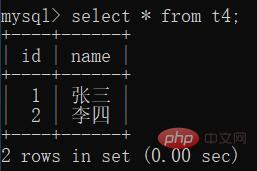
Related free learning recommendations:mysql database(video)
The above is the detailed content of Introducing several ways to replicate tables in MySQL. For more information, please follow other related articles on the PHP Chinese website!

Hot AI Tools

Undresser.AI Undress
AI-powered app for creating realistic nude photos

AI Clothes Remover
Online AI tool for removing clothes from photos.

Undress AI Tool
Undress images for free

Clothoff.io
AI clothes remover

Video Face Swap
Swap faces in any video effortlessly with our completely free AI face swap tool!

Hot Article

Hot Tools

Notepad++7.3.1
Easy-to-use and free code editor

SublimeText3 Chinese version
Chinese version, very easy to use

Zend Studio 13.0.1
Powerful PHP integrated development environment

Dreamweaver CS6
Visual web development tools

SublimeText3 Mac version
God-level code editing software (SublimeText3)

Hot Topics
 1663
1663
 14
14
 1420
1420
 52
52
 1313
1313
 25
25
 1266
1266
 29
29
 1237
1237
 24
24
 MySQL's Role: Databases in Web Applications
Apr 17, 2025 am 12:23 AM
MySQL's Role: Databases in Web Applications
Apr 17, 2025 am 12:23 AM
The main role of MySQL in web applications is to store and manage data. 1.MySQL efficiently processes user information, product catalogs, transaction records and other data. 2. Through SQL query, developers can extract information from the database to generate dynamic content. 3.MySQL works based on the client-server model to ensure acceptable query speed.
 Laravel Introduction Example
Apr 18, 2025 pm 12:45 PM
Laravel Introduction Example
Apr 18, 2025 pm 12:45 PM
Laravel is a PHP framework for easy building of web applications. It provides a range of powerful features including: Installation: Install the Laravel CLI globally with Composer and create applications in the project directory. Routing: Define the relationship between the URL and the handler in routes/web.php. View: Create a view in resources/views to render the application's interface. Database Integration: Provides out-of-the-box integration with databases such as MySQL and uses migration to create and modify tables. Model and Controller: The model represents the database entity and the controller processes HTTP requests.
 MySQL and phpMyAdmin: Core Features and Functions
Apr 22, 2025 am 12:12 AM
MySQL and phpMyAdmin: Core Features and Functions
Apr 22, 2025 am 12:12 AM
MySQL and phpMyAdmin are powerful database management tools. 1) MySQL is used to create databases and tables, and to execute DML and SQL queries. 2) phpMyAdmin provides an intuitive interface for database management, table structure management, data operations and user permission management.
 Solve database connection problem: a practical case of using minii/db library
Apr 18, 2025 am 07:09 AM
Solve database connection problem: a practical case of using minii/db library
Apr 18, 2025 am 07:09 AM
I encountered a tricky problem when developing a small application: the need to quickly integrate a lightweight database operation library. After trying multiple libraries, I found that they either have too much functionality or are not very compatible. Eventually, I found minii/db, a simplified version based on Yii2 that solved my problem perfectly.
 MySQL vs. Other Programming Languages: A Comparison
Apr 19, 2025 am 12:22 AM
MySQL vs. Other Programming Languages: A Comparison
Apr 19, 2025 am 12:22 AM
Compared with other programming languages, MySQL is mainly used to store and manage data, while other languages such as Python, Java, and C are used for logical processing and application development. MySQL is known for its high performance, scalability and cross-platform support, suitable for data management needs, while other languages have advantages in their respective fields such as data analytics, enterprise applications, and system programming.
 Laravel framework installation method
Apr 18, 2025 pm 12:54 PM
Laravel framework installation method
Apr 18, 2025 pm 12:54 PM
Article summary: This article provides detailed step-by-step instructions to guide readers on how to easily install the Laravel framework. Laravel is a powerful PHP framework that speeds up the development process of web applications. This tutorial covers the installation process from system requirements to configuring databases and setting up routing. By following these steps, readers can quickly and efficiently lay a solid foundation for their Laravel project.
 MySQL for Beginners: Getting Started with Database Management
Apr 18, 2025 am 12:10 AM
MySQL for Beginners: Getting Started with Database Management
Apr 18, 2025 am 12:10 AM
The basic operations of MySQL include creating databases, tables, and using SQL to perform CRUD operations on data. 1. Create a database: CREATEDATABASEmy_first_db; 2. Create a table: CREATETABLEbooks(idINTAUTO_INCREMENTPRIMARYKEY, titleVARCHAR(100)NOTNULL, authorVARCHAR(100)NOTNULL, published_yearINT); 3. Insert data: INSERTINTObooks(title, author, published_year)VA
 Solve MySQL mode problem: The experience of using the TheliaMySQLModesChecker module
Apr 18, 2025 am 08:42 AM
Solve MySQL mode problem: The experience of using the TheliaMySQLModesChecker module
Apr 18, 2025 am 08:42 AM
When developing an e-commerce website using Thelia, I encountered a tricky problem: MySQL mode is not set properly, causing some features to not function properly. After some exploration, I found a module called TheliaMySQLModesChecker, which is able to automatically fix the MySQL pattern required by Thelia, completely solving my troubles.




